- Adhering to the principle of sustainable development, conserving the
natural landscape and preserving cultural heritage
- Enhancing the hub functions of Hong Kong
- Providing a good quality living environment
- Meeting housing and community needs
- Providing a framework to develop a safe, efficient, economically-viable
and environmentally-friendly transport system
- Promoting tourism
- Strengthening links with the mainland of China to cope with the rapid
growth in cross-boundary interactions
The Chief Executive, Mr Tung Chee Hwa, announced in his Policy Address in October 2001 an ambitious infrastructure plan worth HK$600 billion (US$77 billion). Of this, one third would be spent on expanding the railway network to make it the backbone of Hong Kong's public transport system.
The investment plan also covers road, land and other construction works that will substantially enhance Hong Kong's quality of life, provide 21st century infrastructure and support the economic restructuring now taking place. In the process, new jobs will be created and significant business opportunities will be available for local and overseas companies.
Railways
From 2002 to 2007, six new rail projects costing US$13 billion (HK$100 billion) will come on line at a rate of about one a year. The existing railway network will be expanded by 40% to over 200 kilometres. Urban areas will be connected with new towns in the eastern and north-western part of the New Territories.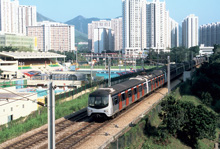
A second rail passenger boundary crossing at Lok Ma Chau will be developed to handle the substantial growth in two-way travel and commerce across the boundary. A dedicated rail link will be built to Hong Kong Disneyland, due to open in 2005.
Plans are being developed for another six new rail projects before 2016. These include a Port Rail line linking the container port at Kwai Chung with the railway network in the Pearl River Delta and a high-speed railway linking Hong Kong to Guangzhou via Shenzhen.
The expansion of the railway network is vital to meeting Hong Kong's increasing transport needs in a sustainable manner. It will also help the Pearl River Delta develop as an integrated regional economy bringing closer economic and social links between Hong Kong and the Mainland, particularly Guangdong Province.
Roads
Over the next decade, more than 100 kilometres of major trunk roads will be constructed and improved, including the Deep Bay Link and the Shenzhen Western Corridor. Total investment on these projects will be over HK$100 billion (US$13 billion).
The proposed Shenzhen Western Corridor will provide a strategic link between Hong Kong and Shenzhen across Deep Bay. It is an integral part of the infrastructure being put in place to provide more and faster cross-boundary links with the Mainland to expedite the flow of people, cargo and capital between Hong Kong and the Pearl River Delta.
Container Port
Container Terminal 9 (CT9), now being built on Tsing Yi Island by the private sector, will consolidate Hong Kong's position as the worlds busiest and most efficient container port. The 68-hectare project will have six berths and a design capacity to handle more than 2.6 million twenty-foot equivalent units (TEUs) a year.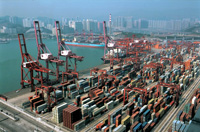
CT9 is expected to be completed in 2004, and will bring annual total capacity at the Kwai Chung Container Terminal Basin to more than 15 million TEUs. The new marine basin will be able to handle the largest container ships currently on the drawing boards.
Another often overlooked fact is that Hong Kong enterprises are the largest external investors in Shanghai and the Yangtze River Delta — in other words Hong Kong companies have been helping to fuel the rapid development of Shanghai and its hinterland while gaining benefits in the process.
Shanghai will continue to develop as the major financial and business centre for the domestic Mainland market, particularly the eastern seaboard, and as the major hub for industrial development in the Yangtze River Delta.
As an international financial centre, Hong Kong casts itself as the business, trading and services hub for the Mainland and the region as a whole. At the same time, Hong Kong and the Pearl River Delta will continue to be the main economic engine of southern China, as well as an increasingly affluent consumer market and a strong regional economy serving the global export market.
| A Tale of Two Regions* | ||
| GDP (US$ billion) |
Exports (US$ billion) |
|
| Hong Kong | 162.6 | 201.9 |
| Pearl River Delta | 258 | 289.1 |
| Shanghai | 55 | 25.4 |
| Yangtze River Delta | 185.4 | 47 |
Hong Kong does have a number of advantages over other Mainland cities, and will continue to do so in the foreseeable future. These do factor heavily in the decision-making process of multi-nationals looking for a regional base, or of small and medium-sized enterprises looking for a foothold in the Mainland market or the Asian region.
The most important is Hong Kong's legal system, which is trusted, tried and tested by international business.
Hong Kong's capital account is fully convertible, and there are no restrictions on foreign exchange dealings. Property, securities, gold and silver can be bought and sold by anyone, without restriction.
A strong and well-regulated financial sector, a free press, the free flow of information, low taxes and a simple taxation system, a pool of managerial talent with international experience, ease of access, proximity to major markets, and a dense network of services firms are among the strengths and advantages of doing business in Hong Kong.
Specifically:
Services: About 86% of Hong Kong's GDP comes from service industries, compared to less than 35% on the Mainland. There will be a large shortfall of skilled professionals and services staff in China. Areas such as management, design and marketing, legal services, transport and logistics, finance and accounting services all correspond perfectly with Hong Kong's niche.
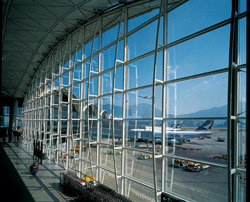 |
Access: Hong Kong has long been an entrepot for trade with the Mainland and is the key conduit for international trade with China. Around one-quarter of the Mainland's imports and 40% of its exports are handled through Hong Kong. More than 31 300 vehicles cross between Hong Kong and Guangdong daily, while over 313 000 people cross between China and Hong Kong daily by land, sea or air. There are about 1 000 flights a week between Hong Kong and 43 Mainland cities.
Financial centre: Predicted increases in FDI into China over the next five years will create great opportunities for Hong Kong's financial services sector – banking, fund management, insurance, underwriting, the debt market. Hong Kong's stock market, the third-largest in Asia after Japan and the Mainland, is considerably more liquid, and more familiar to investors, than Mainland stock markets. Many Mainland companies will look to raise capital in Hong Kong to fund business expansion or modernisation plans.
Experience: Since China opened its doors to the world in the late 1970s, Hong Kong companies have invested more time, money and resources than any others tapping the potential of the Mainland market. Hong Kong shares the same language and culture as China, and draws on more than 150 years of trading and investment experience in the Mainland. Hong Kong's small and medium enterprises have the know-how needed to do business successfully in China. More than 100 000 Hong Kong companies source products from China for the world market.
Low taxes: Hong Kong has low taxes and a simple taxation system. Corporate profits tax is 16%, while salaries tax is capped at 15%. There is no capital gains tax and no withholding tax.
Hong Kong's long-term economic prospects hinge on being able to maintain competitiveness and relevance as a major centre for international finance, trade, transport and logistics, professional services, communications and tourism.
In the past five years, Hong Kong has been positioning itself to sustain reasonable economic growth in a rapidly-changing, knowledge-based world. Two serious economic downturns during that time, coupled with China's entry to the World Trade Organisation, have served to highlight the forces impacting on this goal.
Reforms have been launched in the key areas of financial services, education and the public sector to enhance Hong Kong's attractiveness as a business hub with a highly-skilled workforce and a small, efficient government.
Major initiatives have been undertaken to improve the environment, consolidate and augment Hong Kong's position as Asia's most popular tourist destination and to build the infrastructure needed to ensure continued development as a hub for trade and transport in Asia, and in particular the rapidly growing Pearl River Delta.
Concerted efforts have been taken to promote and position Hong Kong as Asia's world city. The Brand Hong Kong programme, launched in May 2001, is a long-term undertaking to focus greater international attention on Hong Kong's strengths and advantages as the most free, open and cosmopolitan city in Asia.
In July 2000, the government established a dedicated department — Invest Hong Kong (InvestHK) — to spearhead efforts to attract inward investment into Hong Kong. InvestHK actively promotes Hong Kong as the premier business hub in the Asia-Pacific region, and as the best location to access the enormous potential of the Mainland market. Partly as a result, the international business community has taken note of Hong Kong's advantages. Regional operations in Hong Kong rose to 3 237 by June 2001, an 8% increase over the 3 001 in June 2000 and a record high since the survey of regional operations began 11 years ago.
The major reasons companies were attracted to Hong Kong were low and simple taxes, the free flow of information, political stability and security, corruption-free government and excellent communications, transport and other infrastructure.
Boosting links with the Pearl River Delta
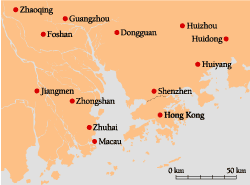 |
The PRD has specific advantages and significant potential as a consumer market, a trading hub, a manufacturing base, a services market and as a destination for investment.
The PRD (including Hong Kong and Macau) is the fastest growing and most affluent region in China. It has a population of about 48 million, which is more than the population of Canada, or Taiwan and Malaysia combined. The PRD has a total GDP of US$258 billion — more than Switzerland, Sweden or Austria — which would put it amongst the world's top 20 economies.
Hong Kong has helped fuel the PRD's rapid growth and development over the past two decades. Hong Kong is the largest investor in the area, and there are more than 36 000 Hong Kong-linked companies employing more than five million people in Guangdong Province.
Hong Kong manufacturers are already the most active and experienced investors in all PRD cities, which make them ideal partners for foreign investors wishing to utilise the PRD's well-established manufacturing capabilities. Hong Kong's wealth of experience in the international trading arena also provides Mainland companies with a ready-made partner to expand operations for the global market.
Despite the depth and breadth of these links, there is a need to significantly boost cross-boundary co-operation to capitalise on existing strengths and synergies and maximize the area's potential, but in a way that preserves Hong Kong's unique advantages under 'One Country, Two Systems'.
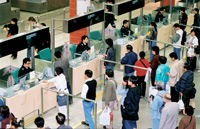 |
More resources will be devoted to hastening the flow of people and goods through such initiatives as co-located Customs and Immigration checkpoints, the development of an electronic cargo clearing system and the opening up of new road and rail routes between Hong Kong and the PRD. There are plans for further co-operation in the logistics sector and to provide ferry services connecting the PRD's major port cities with Hong Kong International Airport. All these initiatives will enhance the export efficiency of the PRD region.
In July 2002, Hong Kong's first Economic and Trade Office in the Mainland will open in Guangzhou to promote economic co-operation and to strengthen business and economic liaison between Hong Kong and the PRD. A major reason for establishing the office is to help Hong Kong businesses to better understand the opportunities emerging in Guangdong following China's WTO entry. The office will also enhance understanding between the HKSAR and Guangdong governments, provide better support for Hong Kong businesses and promote investment in Hong Kong.
A comprehensive strategic planning study — Hong Kong 2030: Planning Vision and Strategy — was announced in February 2001 to set out the blueprint for the development of Hong Kong over the next three decades.
The study aims to provide a planning framework for: